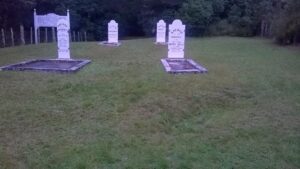1869: Opepe
June 7, 2022
By AHNZ
 Today in New Zealand history, 7 June, 1869, Te Kooti wiped out 9 of a 14-man contingent of Armed Constabulary at Opepe by ambush.
Today in New Zealand history, 7 June, 1869, Te Kooti wiped out 9 of a 14-man contingent of Armed Constabulary at Opepe by ambush.
The site is 18km east of Taupo. I looked for it twice before finding it but, as is the way with these things, it wasn’t really that hard in hindsight.
As a result of the ambush, a redoubt was built and the area became the center of a thriving community. Now it’s just a graveyard with the corners being encroached upon by scrub.
“The inaccuracy and injustice of using the word “massacre” in regard to Opepe was commented upon to me on more than one occasion by two officers who served in the campaigns of the ‘6o’s,’ and who were acquainted with the participants” – Not A Massacre, Misleading Signboard – Ralph Ward, Hawke’s Bay Tribunet (1935); Papers Past

The historic signboard (though probably an instance of The Ship of Theseus paradox) is very old but not the first incarnation marking the spot. In the 1930s there was a little history war about the Opepe Affair being a legitimate ambush or a massacre. An earlier signboard read “massacre.”
Apparently the Government (Department of Internal Affairs) version had it as a “Massacre” of the Maori Wars. Then, the Automobile Association updated the sign and dropped the word ‘massacre’ to reflect that however much Te Kooti’s terrorist cult may have been despised, this was a legitimate military surprise attack and no war crime. In particular, the surprise element is down to the Armed Constabulary failing to set a watch.
This is also a reminder that it was the Automobile Association and not Government that gave New Zealand her signposts and road markings. The government simply came along afterwards and took over as they always do. Ref. 1915: Automobile Associations
Interesting to note, too, that the same revisionism is with us today concerning the Wairau Affray. In June 2022 Philip Temple’s article White man’s history: The execution of Arthur Wakefield for Newsroom revisits an 1840s Maori massacre and re-brands it an ‘execution’. Just like Opepe and many other engagements there are legitimate differing points of view but also contrived illegitimate points of view driven by grant money and government-funding. If a story can be changed, a name added or subtracted from a signboard, then money and property can change hands. Power and compensation can flow back and forth depending on who gets to write the history books. There is nothing particularly one-sided in Temple’s article selecting ‘massacre’ vs ‘execution’ but the title “white man’s history” and “execution” does choose a side and appeal to the Woke reader.
This is why we can’t have Government history picking winners. The State funding of history pollutes our timeline as events and their meaning are manipulated and invented in an attempt to get at money and power rather than get at the truth. There is no single point of view that a Ministry of Truth or Government History Curriculum can reveal to us. Especially, the process of learning history is not helped along by giving out prizes and punishments for findings that help or hinder the political fashion ‘current thing’ of the given moment.
—
Image ref. AHNZ Archives (2019)
 Like Comment Share
Like Comment Share





